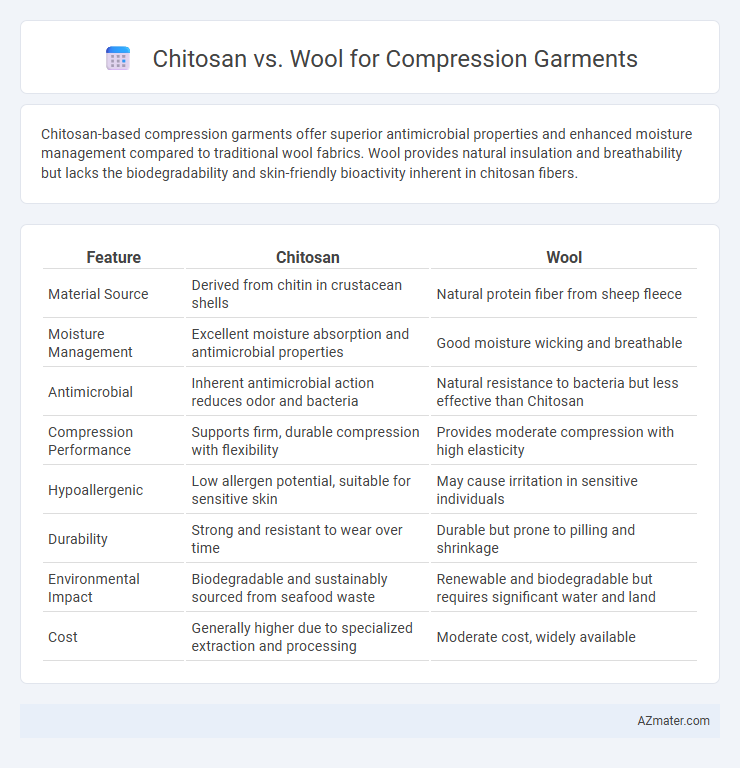Chitosan-based compression garments offer superior antimicrobial properties and enhanced moisture management compared to traditional wool fabrics. Wool provides natural insulation and breathability but lacks the biodegradability and skin-friendly bioactivity inherent in chitosan fibers.
Table of Comparison
| Feature | Chitosan | Wool |
|---|---|---|
| Material Source | Derived from chitin in crustacean shells | Natural protein fiber from sheep fleece |
| Moisture Management | Excellent moisture absorption and antimicrobial properties | Good moisture wicking and breathable |
| Antimicrobial | Inherent antimicrobial action reduces odor and bacteria | Natural resistance to bacteria but less effective than Chitosan |
| Compression Performance | Supports firm, durable compression with flexibility | Provides moderate compression with high elasticity |
| Hypoallergenic | Low allergen potential, suitable for sensitive skin | May cause irritation in sensitive individuals |
| Durability | Strong and resistant to wear over time | Durable but prone to pilling and shrinkage |
| Environmental Impact | Biodegradable and sustainably sourced from seafood waste | Renewable and biodegradable but requires significant water and land |
| Cost | Generally higher due to specialized extraction and processing | Moderate cost, widely available |
Introduction to Compression Garments
Compression garments are specialized apparel designed to apply controlled pressure to specific body areas, enhancing blood circulation and reducing muscle fatigue. Chitosan-based compression garments offer antimicrobial properties and moisture-wicking capabilities, promoting skin health during extended wear. Wool compression garments provide natural insulation and breathability, supporting thermal regulation while maintaining consistent compression levels.
Understanding Chitosan: Origins and Properties
Chitosan, derived from the shells of crustaceans such as shrimp and crabs, is a natural biopolymer known for its exceptional biocompatibility, biodegradability, and antimicrobial properties. Its high molecular weight and positive charge enable it to interact effectively with skin, making it ideal for compression garments that require enhanced moisture management and odor control. Unlike wool, which is valued for its thermal insulation and elasticity, chitosan offers added benefits of wound healing and skin regeneration, providing multifunctional advantages in medical and athletic compression wear.
Wool: Natural Fiber Characteristics
Wool, a natural protein fiber obtained from sheep, offers excellent moisture-wicking properties and breathability, making it ideal for compression garments that require effective temperature regulation. Its inherent elasticity provides a comfortable fit and maintains compression without restricting movement, while its antimicrobial properties help reduce odor during prolonged wear. Compared to synthetic fibers like chitosan, wool's biodegradability and natural resilience contribute to sustainable and durable compression garment solutions.
Moisture Management: Chitosan vs Wool
Chitosan fibers exhibit superior moisture-wicking properties compared to wool, rapidly absorbing and evaporating sweat to keep the skin dry and comfortable during prolonged wear. Wool naturally regulates moisture by absorbing up to 30% of its weight in water vapor without feeling damp, providing gradual release that maintains thermal balance. The antimicrobial nature of chitosan also helps reduce odor caused by bacterial growth, enhancing hygiene in moisture management for compression garments.
Breathability and Comfort Comparison
Chitosan fibers exhibit superior breathability and moisture-wicking properties compared to wool, enhancing comfort during prolonged wear in compression garments. Wool provides natural insulation and moderate breathability but tends to retain moisture, which may reduce overall comfort under compression. The antimicrobial qualities of chitosan also contribute to fresher, more hygienic wear, making it a preferred choice for breathable, comfortable compression clothing.
Antimicrobial and Hypoallergenic Qualities
Chitosan fibers exhibit superior antimicrobial properties by inhibiting bacterial growth, making them ideal for compression garments that require hygienic wear. Wool, while naturally hypoallergenic and breathable, may harbor allergens or irritants in some sensitive individuals, reducing its suitability for those with skin sensitivities. The combined antimicrobial efficiency of chitosan and the moisture-regulating capacity of wool form a basis for selecting materials tailored for comfort and skin health in compression wear.
Durability and Maintenance Requirements
Chitosan-based compression garments offer enhanced durability due to their antimicrobial properties, which prevent degradation from sweat and bacteria, extending garment lifespan compared to traditional wool. Wool compression garments require more maintenance as they are prone to shrinking and matting when exposed to frequent washing or harsh conditions, necessitating gentle care to preserve elasticity and compression effectiveness. The inherent resistance of chitosan fibers to wear and moisture makes them a low-maintenance choice for long-term use in compression wear applications.
Environmental Sustainability and Biodegradability
Chitosan-based compression garments offer superior environmental sustainability due to their origin from renewable marine biomass and inherent biodegradability, breaking down naturally without releasing harmful substances. Wool, derived from sheep, is a renewable and biodegradable fiber but its environmental impact varies depending on grazing practices and processing methods, which can contribute to higher resource use and emissions. Both fibers support eco-friendly compression garment production, but chitosan's antimicrobial properties and efficient biodegradation give it a distinct advantage in sustainable textile applications.
Cost and Accessibility Factors
Chitosan compression garments generally have a higher production cost due to the complex extraction and processing of chitosan from crustacean shells, which makes them less affordable compared to wool-based options. Wool compression garments are more accessible and widely available, benefiting from established manufacturing processes and abundant raw materials, resulting in lower retail prices. Cost efficiency and broader market availability often make wool preferred for consumers prioritizing affordability and easy procurement.
Choosing the Best Material for Compression Garments
Chitosan offers natural antibacterial properties and excellent moisture-wicking capabilities, making it ideal for compression garments that require hygiene and comfort during prolonged wear. Wool provides superior thermal regulation and elasticity, maintaining consistent pressure while adapting to body movements in compression clothing. Selecting between chitosan and wool depends on prioritizing antimicrobial benefits and breathability versus insulation and stretchability for effective compression therapy.

Infographic: Chitosan vs Wool for Compression Garment
 azmater.com
azmater.com